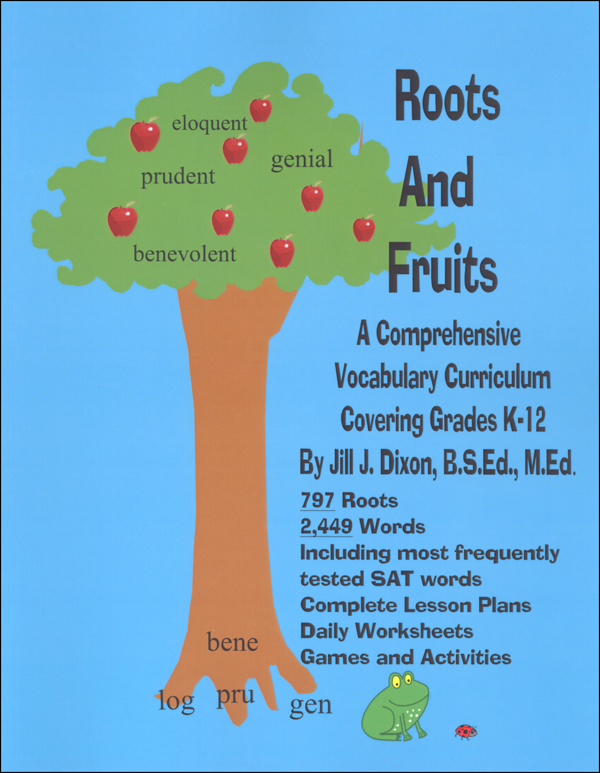Roots and Fruits teaches vocabulary based on Greek and Latin roots, but it is unusual because it was designed for teaching children of all ages from kindergarten through high school and because it incorporates teaching methods for various learning styles.
The program teaches 797 roots and 2,449 vocabulary words based upon those roots. Many of the vocabulary words are those found on the SAT. The book is only 85 pages, which doesn’t sound large enough to accomplish all of this. But Roots and Fruits does it by providing lists of roots and vocabulary words plus general instructions, a suggested lesson plan to follow for each week, directions for games and activities that will be used over and over again, and 16 pages of reproducible activity sheets that will be used repeatedly.
The flexibility of this program that allows you to tailor lessons to fit various ages and learning styles also means that you have to spend more time planning lessons, deciding which activities to use, preparing sample sentences, and presenting lessons. While there are other programs that are easier to use for older students, I don’t know of another program that teaches Greek and Latin roots to children below third grade. And any method for teaching vocabulary to young children is going to require parent involvement.
Also, Roots and Fruits teaches dictionary skills while also working on spelling, decoding, and writing skills rather than just vocabulary. You can choose from among the activities those most suitable for each child. It seems to me that children who are beginning readers need to be able to at least read three-letter words. But once children have gotten that far, Roots and Fruits might even help speed up development of reading skills since the word roots should help children grasp the idea that words often have more than one syllable, and that we can decode those by recognizing syllables that come from root words.
Each week’s lesson begins with the parent presenting roots or prefixes along with related vocabulary words, explaining their meanings. Students read the words and look them up in a dictionary. Students should write down two or three synonyms on notecards or in a notebook. With young children you will start with only one root per week, so this is manageable for them with assistance. Using the dictionary, older students will identify whether a root or prefix is Greek or Latin, and they will also determine the part of speech. Dixon recommends particular dictionaries that have the necessary information about word derivations.
On Tuesdays through Thursdays each week, students will review their note cards, reading them aloud then creating sample sentences for each vocabulary word. Each day you will choose one or two of the activities, games, or worksheets to use for reinforcement.
On Fridays, students should use each vocabulary word in a sentence, sometimes combining two or more vocabulary words within one sentence—this might be done orally or in writing. If time permits, use another game or activity. Lessons should take no more than 15 minutes a day.
Young children might try to create silly sentences using their new words while older students might use a worksheet to create rhyming clues for their vocabulary words. Some activities and games require two or more students, and most activities will be more fun with at least two students. However, there are activities for a single student. With children of different ages, they can learn some roots and words together, then older students can be given additional roots and words to learn.
If you want to test students, you will need to create your own tests, but Dixon provides suggestions for creating tests with matching and fill-in-the-blanks questions.
You can use Roots and Fruits over a number of years, keeping note cards from previous years so students can continually review words they’ve already learned. The fact that you can use Roots and Fruits with all of your children without having to buy workbooks or other resources each year makes this a very affordable resource.









